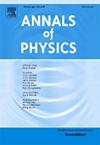Testing strong gravitational lensing effects of supermassive black holes with string-inspired metric: Observational signatures and EHT constraints
IF 3
3区 物理与天体物理
Q2 PHYSICS, MULTIDISCIPLINARY
引用次数: 0
Abstract
We analyze gravitational lensing in the strong field limit for spherically symmetric string-inspired Euler–Heisenberg black holes, characterized by magnetic charge () and Einstein–Maxwell-dilaton coupling constants () from the low-energy limit of heterotic string theory. Our results show that the string coupling has a weak impact on the positions of relativistic images, deflection angles, photon orbit radii, and shadow sizes, making these black holes indistinguishable from the Gibbons–Maeda–Garfinkle–Horowitz–Strominger (GMGHS) black holes with the same mass and charge. Compared to Schwarzschild black holes, the string-inspired Euler–Heisenberg black holes exhibit smaller deflection angles, decreasing with increasing charge. Moreover, the time delay for Sgr A * and M87 * can reach and min, respectively, at and , deviating from Schwarzschild black holes by and min, which are not very significant. For Sgr A* and M87*, we determine range within as, and as respectively, with angular separations ranging from nas for Sgr A* and nas for M87*. EHT bounds on the of Sgr A* and M87* within the interval bound the as: for Sgr A* and for M87* , while in both the cases, we did not find any bound on the parameter . We show that string-inspired Euler–Heisenberg black holes and EHT observations agree in the finite parameter space. A discussion on the effective metric has been included.
用弦激发度规测试超大质量黑洞的强引力透镜效应:观测特征和EHT约束
利用磁荷(q)和爱因斯坦-麦克斯韦-膨胀耦合常数(α,β)从异质弦理论的低能极限出发,分析了球对称弦激欧拉-海森堡黑洞在强场极限下的引力透镜效应。我们的研究结果表明,弦耦合对相对论图像的位置、偏转角度、光子轨道半径和阴影大小的影响较弱,使得这些黑洞与具有相同质量和电荷的gibbons - maida - garfinkle - horowitz - strominger (GMGHS)黑洞难以区分。与史瓦西黑洞相比,弦激发的欧拉-海森堡黑洞的偏转角较小,且随电荷的增加而减小。此外,在q=0.1和η=−1时,Sgr A *和M87 *的时间延迟分别为11.477和17349.8 min,与史瓦西黑洞的偏差分别为0.0198和28.9 min,但并不十分显著。对于Sgr A*和M87*, θ∞范围分别为(11.52,26.33)μas和(9.17,19.78)μas,角间距分别为(3.29-6.85)nas和(2.47-5.15)nas。Sgr A*和M87*的θsh在1σ区间内的EHT界为:Sgr A* 0.54109≤q≤0.7796和M87* 0<;q≤0.29107,而在这两种情况下,我们都没有发现参数η的任何界。我们证明了弦激励的欧拉-海森堡黑洞和EHT观测在有限参数空间中是一致的。本文还讨论了有效度量。
本文章由计算机程序翻译,如有差异,请以英文原文为准。
求助全文
约1分钟内获得全文
求助全文
来源期刊

Annals of Physics
物理-物理:综合
CiteScore
5.30
自引率
3.30%
发文量
211
审稿时长
47 days
期刊介绍:
Annals of Physics presents original work in all areas of basic theoretic physics research. Ideas are developed and fully explored, and thorough treatment is given to first principles and ultimate applications. Annals of Physics emphasizes clarity and intelligibility in the articles it publishes, thus making them as accessible as possible. Readers familiar with recent developments in the field are provided with sufficient detail and background to follow the arguments and understand their significance.
The Editors of the journal cover all fields of theoretical physics. Articles published in the journal are typically longer than 20 pages.
 求助内容:
求助内容: 应助结果提醒方式:
应助结果提醒方式:


